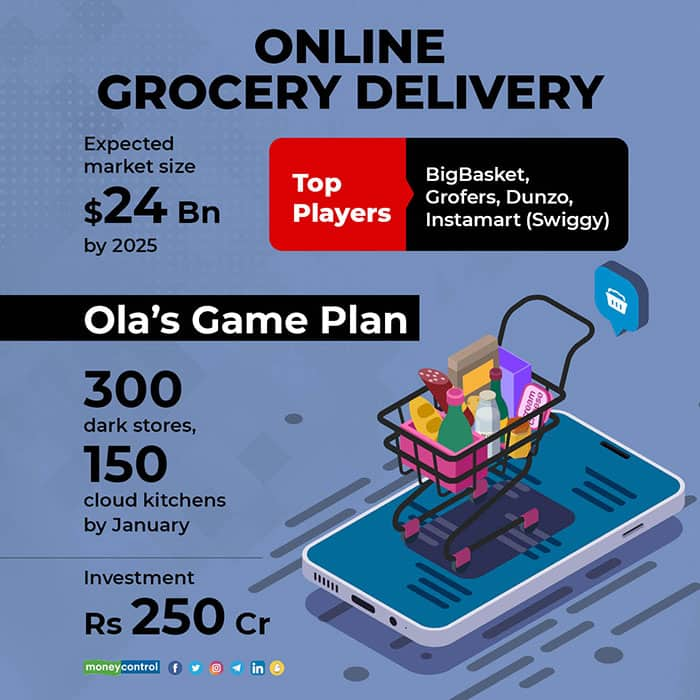
Image Source: ShutterStock
In July 2015, ride-hailing startup Ola launched a standalone online grocery store in Bengaluru, quick on the heels of a food delivery app in March the same year. The idea was to use its cabs and drivers to also deliver groceries, between 9 am and 11 pm.
Less than nine months later, it shut both Ola Store and Ola Foods without going into detail.
“As we strengthen our focus on building mobility for a billion people, we are drawing these two experiments to a close and taking learnings from these to serve you better in the time to come,” it said in a March 2016 blog.
Five years on, it seems Ola is ready to wade into the hyper-competitive grocery delivery space yet again. Quick commerce, a segment in which apps such as Grofers, Swiggy and Dunzo offer delivery of essential products in 10-30 minutes is in vogue again and Ola wants a piece of the action.
Ola founder Bhavish Aggarwal is aggressively building an electric two-wheeler business via Ola Electric, the EV company in which the ride-hailing entity owns less than a 10 percent stake. Ola needs a diverse portfolio of businesses that goes beyond cab aggregation and rides as it prepares to hit the public markets soon. That may be the reason it is trying to revive its online food and grocery delivery businesses.
But hyper-local grocery delivery can be a brutal game, as Ola learnt a few years ago. Grocery delivery apps that were all the rage in 2015- PepperTap and LocalBanya- had to shut down because they logged negative margins per delivery.
Dark store model
More recently, Zomato, which entered the segment before its initial public offering (IPO), shut it within months although it has a strategic stake in Grofers.
Ola is hoping to replicate the success that food delivery app Swiggy has had with Instamart. It used to once operate as a grocery marketplace where Swiggy used to aggregate stores; Instamart now has a more efficient dark store model, stocking essentials.
Moneycontrol learns that Ola has set aside a budget of Rs 250 crore for the grocery delivery business with a mandate to start this division by mid-November.

The plan is to set up 300 dark stores for grocery and convenience delivery by January just ahead of its $ 2 billion IPO, which is being timed for February. The company, which has 55 cloud kitchens, also plans to expand the number to 150-160 by January, according to people with knowledge of the development.
It wants to clock a revenue run rate of Rs 100 crore per month before the IPO takes, one of the people above said, requesting anonymity. The company’s vision is to widen the use cases and make Ola a one-stop hyper-local platform, the person said.
Ola did not respond to queries on plans for the business.
Challenges
Taking a leaf from Swiggy’s Instamart, Ola plans to set up micro-fulfilment centres in close proximity to users. For instance, big cities like New Delhi or Mumbai will have 40 centres each while Chennai may just have 10.
These dark stores will have curated stock-keeping units (SKUs) of around 1,700-1,800 targeting customers living in the vicinity.
Ola confronts unique challenges. One big challenge is a high rate of employee attrition. The pilot for grocery delivery was earlier scheduled to start in August, but did not take off. The next tentative deadline is mid-November.
The plan comes at a time when top executives like Ola’s founding partner Pranay Jivrajka, who was heading the food division, among many others, have exited the company.
Ola brought in Vinay Bhopatkar from Café Coffee Day as the chief executive officer of Ola Delivery, the new vertical which will house food and grocery, in August.
With the recent exit of Gaurav Porwal, the chief operating officer, the responsibility of supply mobility has also to be borne by Bhopatkar.
“He is giving only 20 percent of his bandwidth to food/delivery. The rest 80 percent is going to mobility. Even though we have a leader on paper, we don’t have a leader in reality,” said another person who has been associated with the hyper-local project at Ola.
“It is not because we don’t want to do it but because people have exited left, right and centre. The team is hollow at this point in time. Things are obviously moving at one-third the pace they could have if they were rightly staffed,” he added.
Also read: Exclusive: IPO-bound Ola’s COO and CFO to exit the company
Ola Foods
Ola has already started delivering food under the brand Ola Foods on its app in select regions.
Unlike Swiggy or Zomato, which aggregate restaurants, Ola is focussing only on its private-label brands.
The company currently runs around half-a-dozen private label food brands –- Khichdi Experiment, Bowlsome, Paratha Experiment, Biryani Experiment, That Pizza Place and Nashta Express. It has around 700 people working in this segment including cooks and cleaners besides corporate employees all on its payroll.
Hitherto, Ola used to sell these brands via aggregators like Swiggy and Zomato. It has not snapped ties with those platforms, but has reduced discounts it offered.
“Where 70 percent of the whole business was coming from Swiggy and 30 percent from Zomato, now it is 50 percent coming from the Ola platform while 30 percent from Swiggy and 20 percent from Zomato,” said the person cited above.
Ola is doing these deliveries with a dedicated set of riders who are on the company’s payroll. On top of that, it has on-boarded logistics company Shadowfax to take care of a surge in demand.
Outside every one of its kitchens, Ola has stationed six to seven riders. These numbers are also expected to increase exponentially with the launch of the grocery business or Ola Stores, as the employees call it.
Having burnt its fingers across the food and grocery space in the past, what does Ola expect to be different this time around?
Timing is everything
Previously, Ola would pick up orders from retailers and deliver them to consumers. This time, it will have in place dedicated infrastructure that is likely to improve assortment and supply.
The second issue is timing. With companies like Grofers and Swiggy fighting a delivery-in-minutes war, expectations of customers have shot up. A newcomer has no chance of success unless it wants to enter into the 15 minutes race since this has become an industry standard now.
Now to ensure that lightning speed, companies need to invest in people who do everything from receiving orders to assorting and packing products up in two to three minutes besides building a robust technology.
The cost of setting up a dark store in a metro for Ola would come to around Rs 40 lakh. This will include licensing, civil works and equipment.
Ola is slightly behind rival Swiggy, which is also in the cloud kitchen space besides aggregating restaurants. People familiar with the development said Swiggy fulfils around 250-300 orders a day per outlet from its cloud kitchen brands such as the Bowl Company.
Ola Kitchens, on the other hand, generates 150-200 orders per day from each kitchen.
Swiggy’s numbers quoted are only from its cloud kitchen brands. Its overall food delivery numbers are way higher.
Cash burn
On the grocery end, Swiggy’s single dark store gets around 900 orders on a daily basis. This is the segment Ola is trying to crack.
According to the people cited above, average ticket size of food delivery at Ola is Rs 350-400 but to earn money on this, the cash burn is massive.
“We burn about Rs 6-7 crore a month in the food business. Assuming there is a margin of 20-30 percent; we are basically burning this Rs 7 crore on making Rs 3 crore,” said the person cited in the first instance, mentioning September’s data.
The grocery segment will have even thinner margins. According to experts, packaged consumer goods entities work on 15-20 percent margins on products.
“In the first few years, this margin will easily be eaten up by the manpower and infrastructure cost,” the person said.
It remains to be seen if Ola will be second time lucky or if it burning the candle at both ends.

